April 11th, 2024
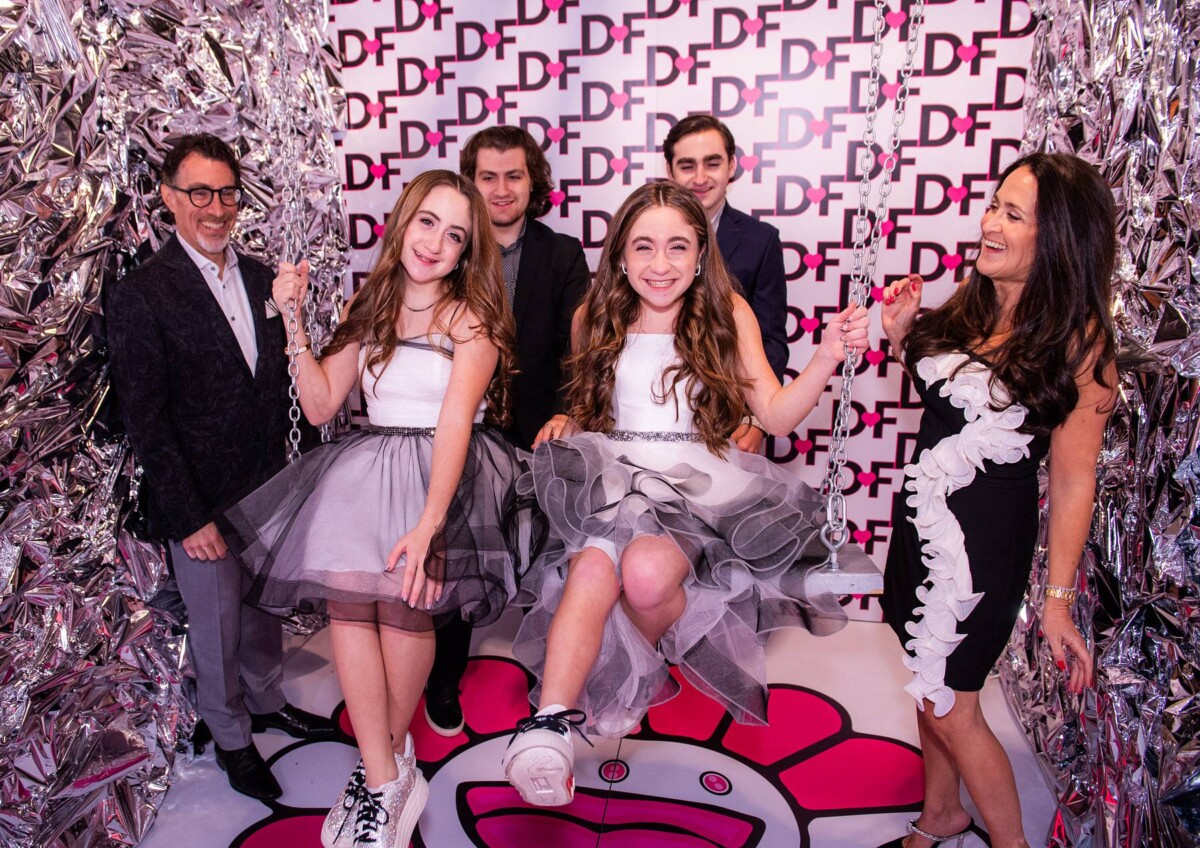
The Mitzvah celebrations for Fallon and Daniela Kyler-Wank started in December of 2022 when the twins had their service in Jerusalem, with a family celebration at home a year later. For their public, “mostly kids” celebration in November, the young ladies wanted to host a fun time — but wanted to think outside the traditional “rectangle room.”
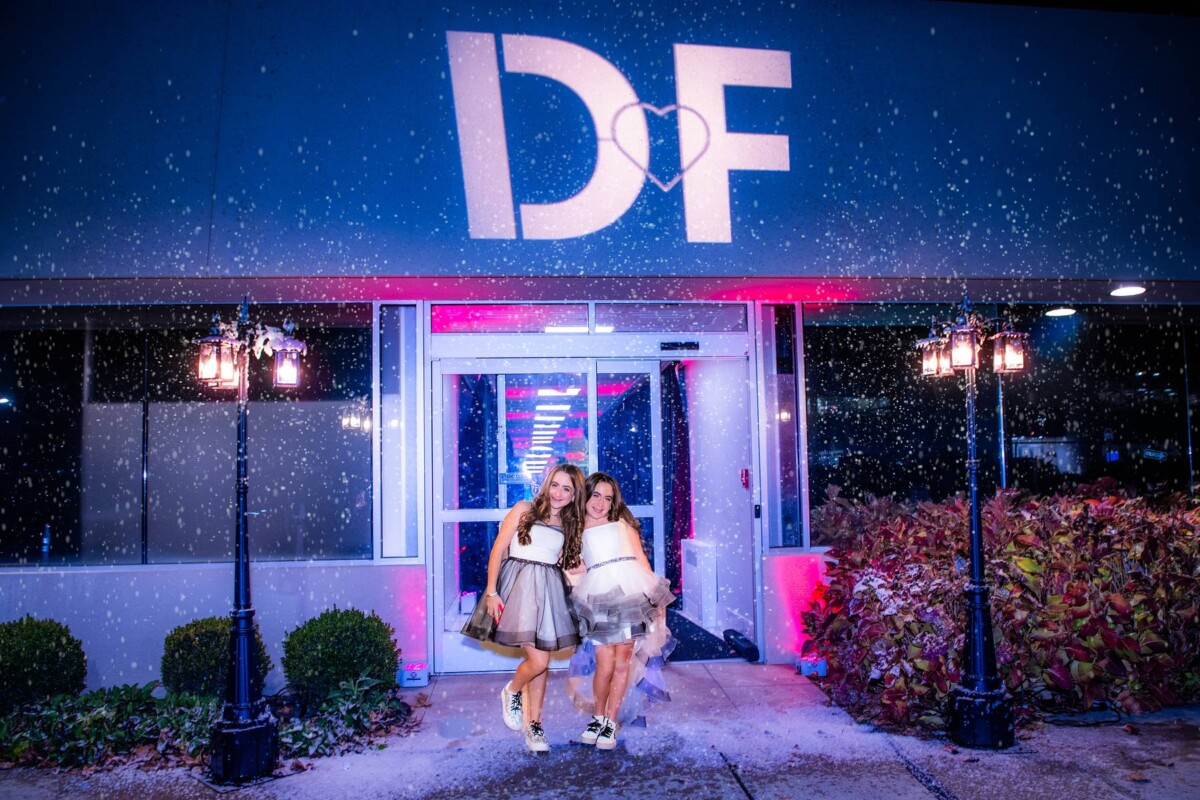
Daniela & Fallon in front of these beautiful Snowfall Lamp Posts! The Vault is hidden away in a building in Uniondale, so the LED gobo projection and lanterns with fake snow, helped guest know exactly where the party was located.
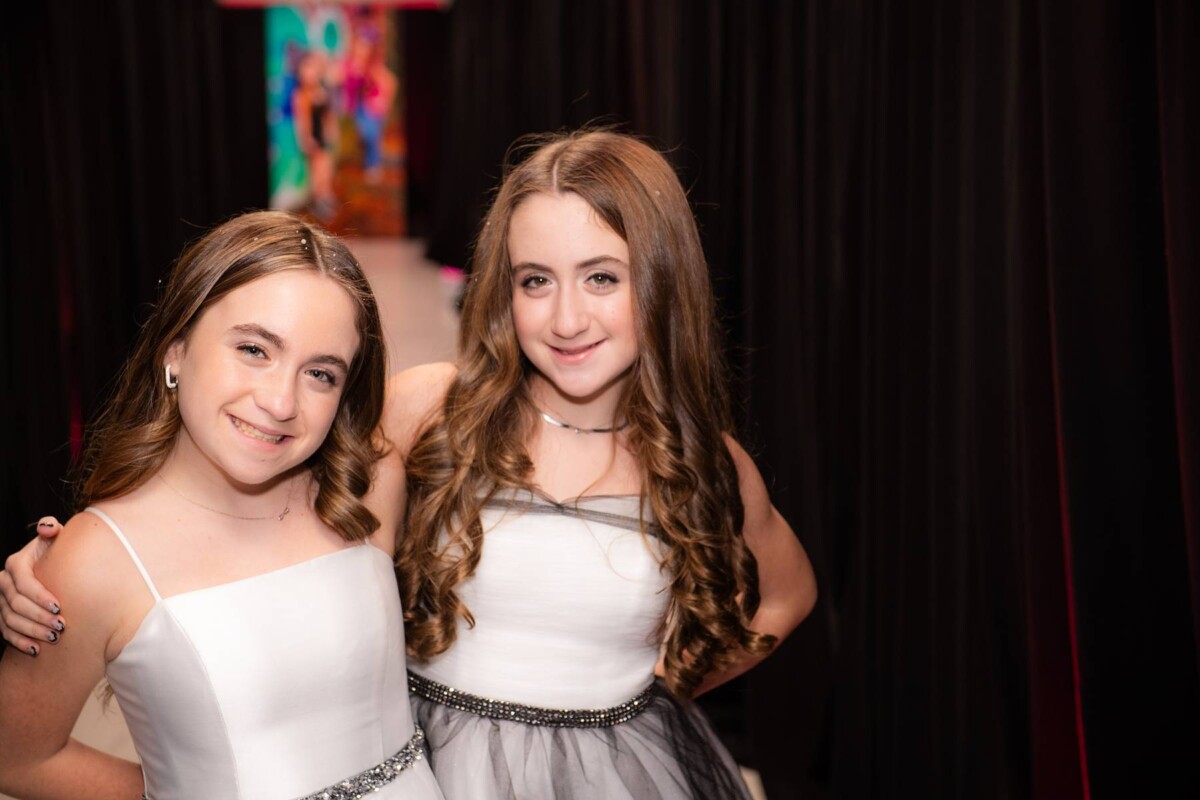
Fallon & Daniela in the entrance to The Vault, fully draped by National Event Connection to transform the path to the party! Allison Adise and her crew transformed the entire building from the second we walked in the door.
They were thrilled when Allison Adise, operating owner of Events By Adise, in partnership with National Event Connection, found Uniondale’s newest and coolest party venue, The Vault. Working with the production team at NEC and talent of EJ The DJ, Adise was able to transform this underground space, which had in the past been used to protect high-end jewelry, into a fantastic party world!
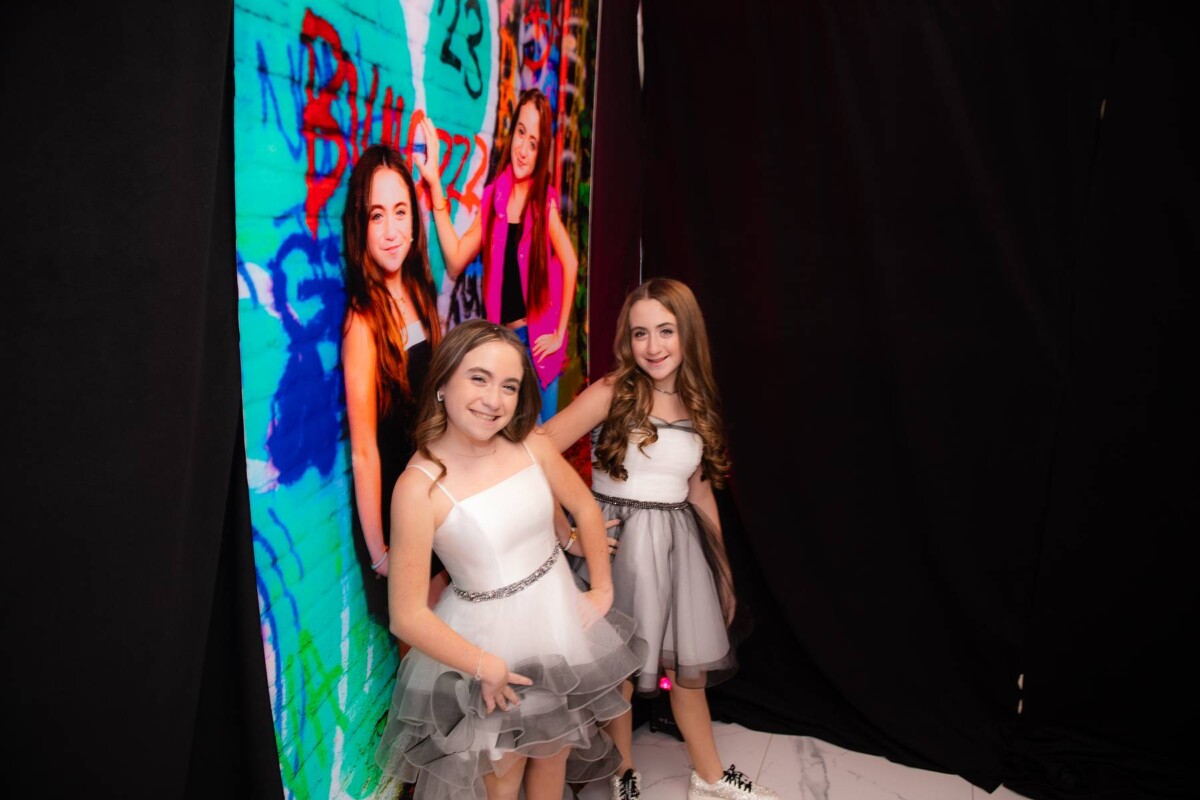
Daniela and Fallon, ready to party and in front of one of the enlarged high resolution photo prints of the twins produced by PrintIt by NEC.
A month earlier, a photographer had captured Fallon and Daniela in candid moments and giant prints of these photos adorned the entire space, starting with the welcome sign. Guests signed in by writing congratulatory messages on giant light-up mirrors, lovely keepsakes the twins now keep in their rooms as mementos of their special day.
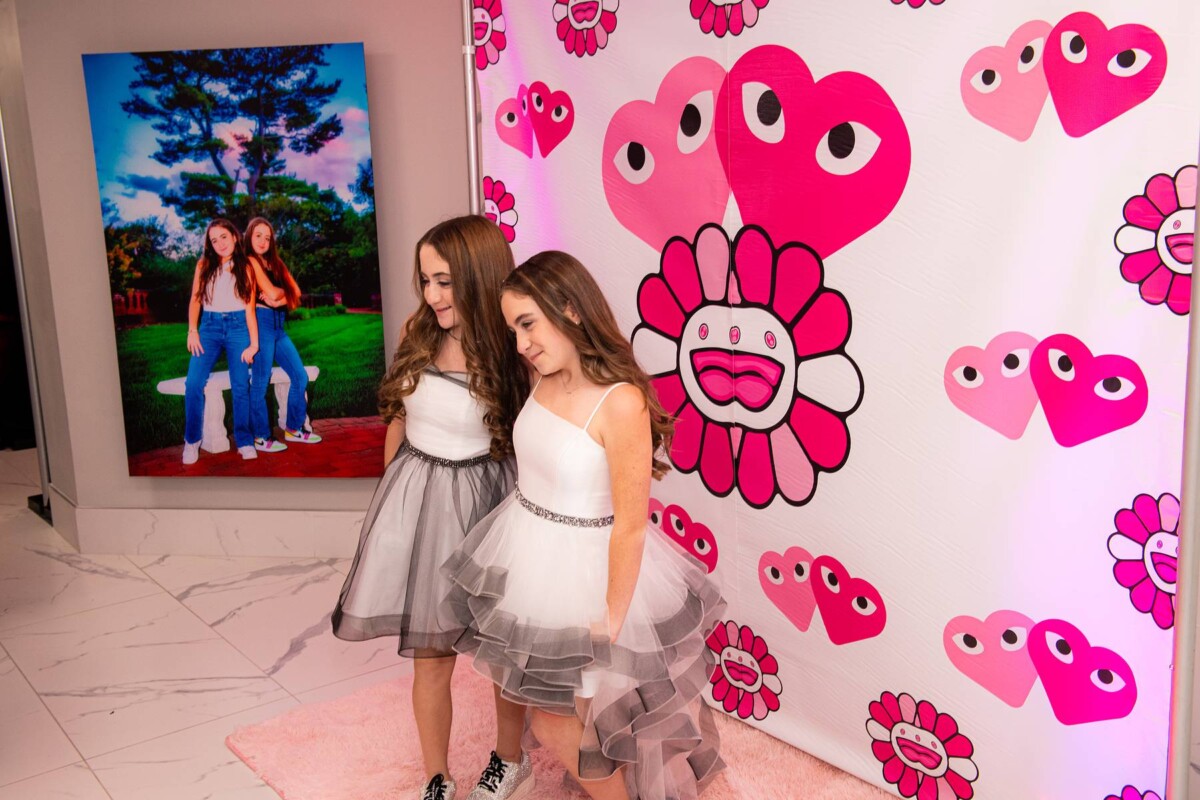
A custom designed and produced Step & Repeat paired with matching carpet. Guests were greeted by the strolling photographer at the first of many photo-ops. It was important to us to try to get photos of as many guests as possible, to help document the entire evening.
One of the highlights of the party happened when Fallon and Daniela unveiled the glow room. The room featured neon paint splatters, sayings and quotes associated with the honorees, and lots of comfortable seating for guests to visit and enjoy the party atmosphere.
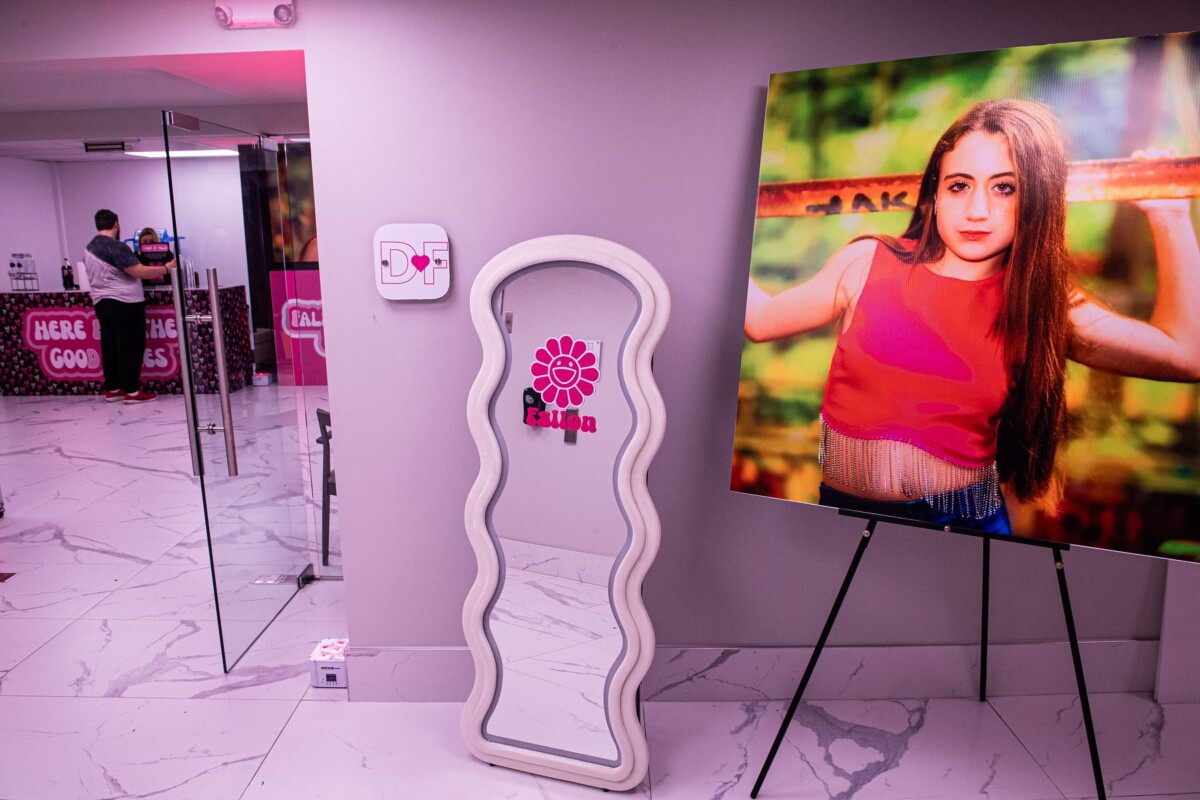
We wanted unique, but useful, sign-in boards. The full-size mirrors actually light-up, and are now perfectly situated in each of the girls’ bedrooms at home with messages of love from their friends as constant reminders of their fabulous party!
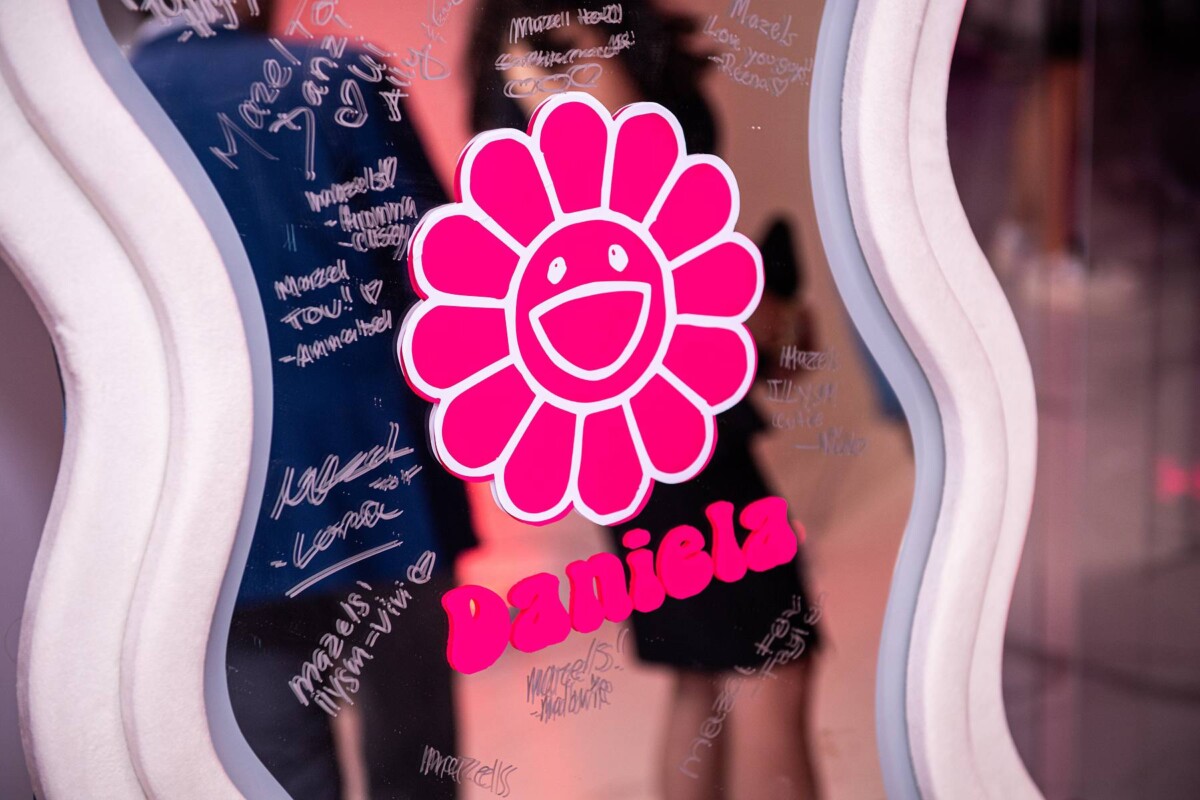
The light-up standing mirrors provided by National Event Connection as our sign-in boards.
The Vault features a room-sized safe that in another era stored valuable jewelry, which the young ladies decided was the perfect place to distribute party favors, put together by Howie Zwang of Gotham Shirts. EJ the DJ MC CL kept guests dancing while a videographer from the National Event Connection (NEC) captured partygoers as they enjoyed the many rooms that comprised the space. For keepsake photos, also by NEC, a special room at the venue called The Boardwalk was transformed into an entire walk-in photo booth.
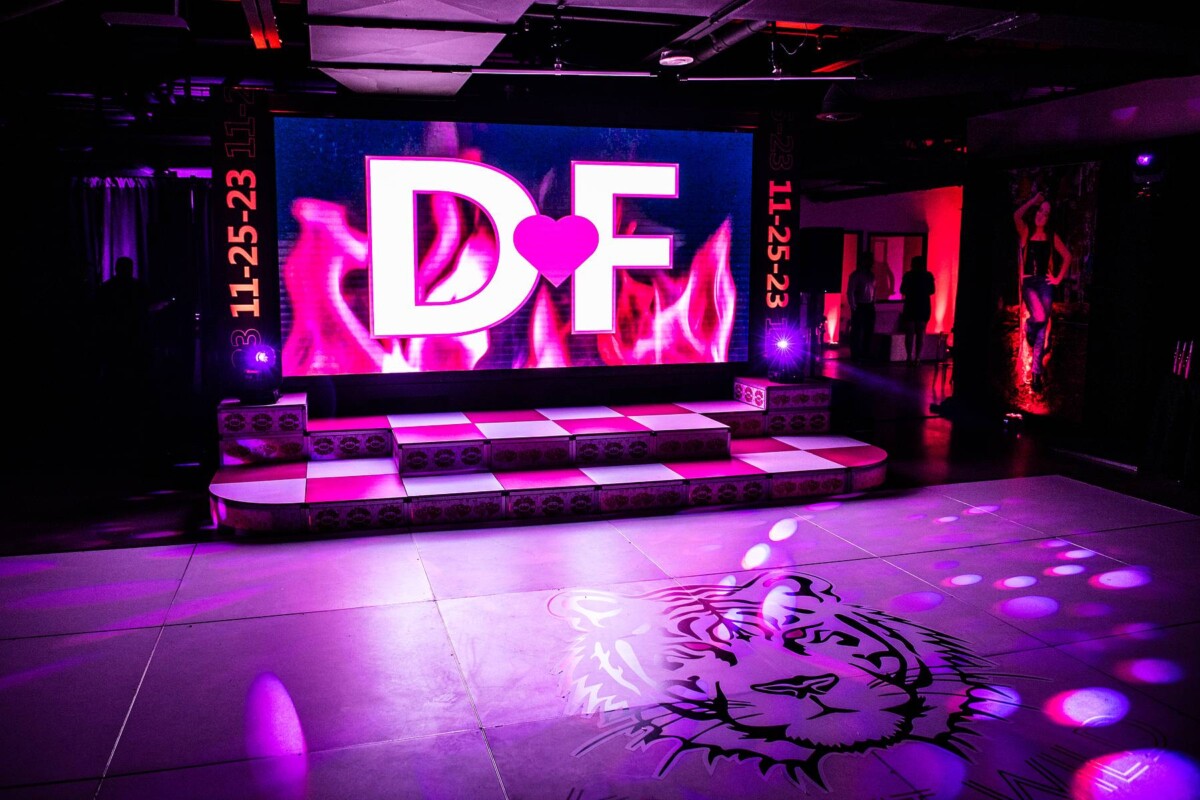
The LED Video Wall was the perfect centerpiece for the dance floor. Allison Adise surprised the family by branding the large platform stage and white dance floor. A giant logo adorned the dance floor to complete the look!
The girls’ mother, Alison Kyler-Wank, reports that “Fallon, Daniela, their parents, and all their friends and guests had a unique, exciting, high-energy fabulous night.”
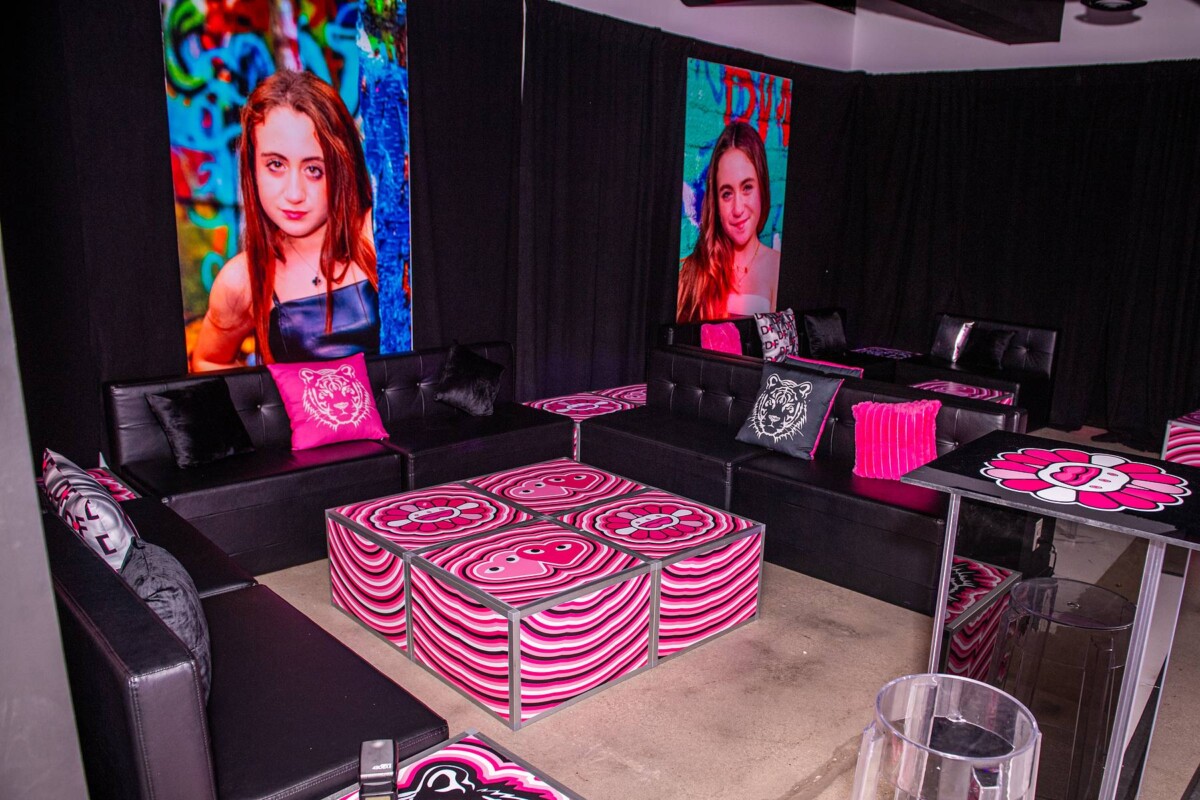
The family trusted Allison Adise’s vision for the room setup and she did not disappoint! The lounge was perfect and complete with personalized coffee tables, stylish black couches, wall to wall black drape, customized high tops, and more high resolution enlarged photos!
Instead of gifts, Fallon and Daniela decided that the best way to help them celebrate their Mitzvah journey was for guests to make donations in their name to Israel as well as to the Crohn’s & Colitis Foundation.
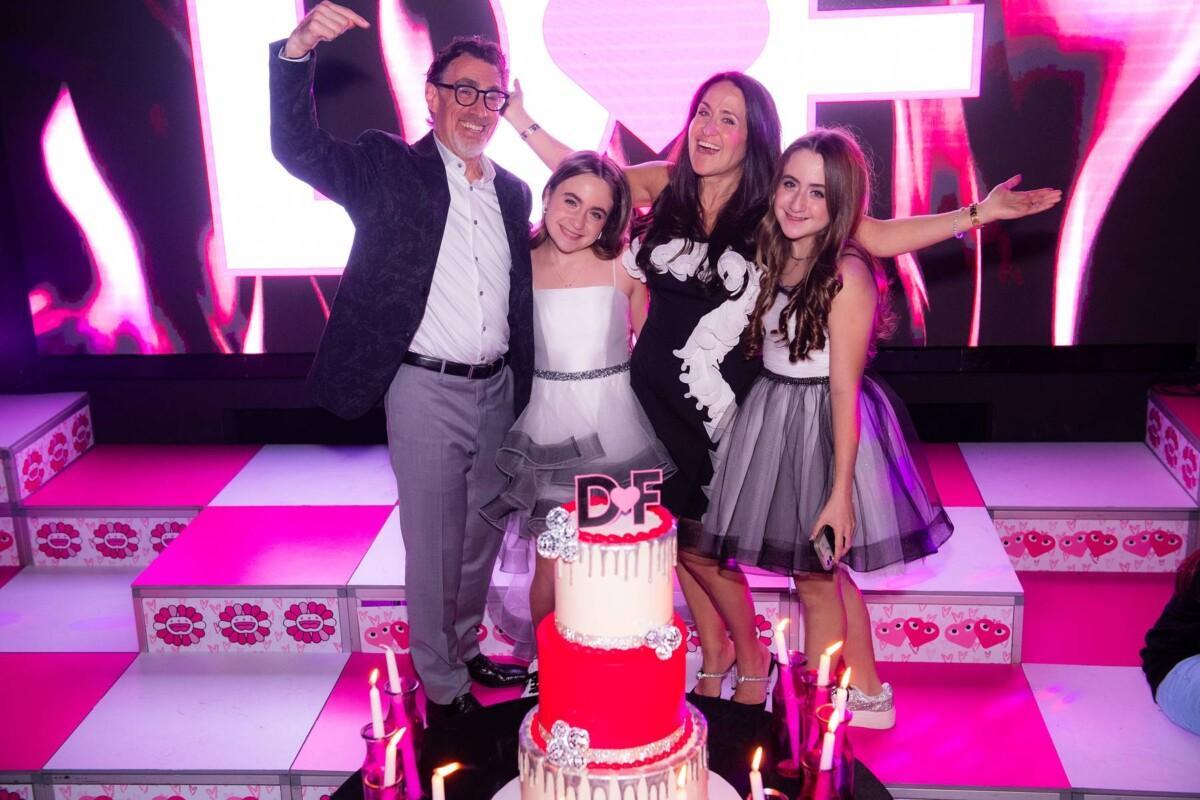
The family posing in front of the cake, happy as ever!
April 1st, 2024
10 B’nai Mitzvah in Iconic Venues in NYC
By Drew Isserlis Kramer
When Jewish children reach the age of 12 or 13, they celebrate a b’nai mitzvah. With or without a ritual ceremony, reaching this age declares Jewish tweens to be adults in the eyes of their congregation and community. With this coming of age ritual comes great responsibility. After this milestone, children are held responsible for their own actions, in charge of upholding the tradition and ethics of the Jewish people. With this great responsibility also comes a great party. While historical evidence of b’nai mitzvah celebrations exists from as early as the 12th century, the big business of b’nai mitzvah parties hit its stride in the 1950s. Due to increasing affluence in the American Jewish community, the 1950s gave rise to themed b’nai mitzvah parties with lavish decorations, musical entertainment and professional videographers. At the epicenter of this event planning boom was New York City. Home to the largest population of Jewish people in the United States, Jewish parents and their 300 friends continue to get their hora on at some of the most iconic venues in the city.
According to New York-based luxury event planner Casey Kaufman of Imagine Party and Events, “there are not a lot of venues in the city that can hold a massive amount of people.” While many families initially hope to create intimate celebrations, guest lists often swell with the child’s camp friends and school friends. Since living grandparents often contribute to these milestone moments, they too require a generous head count. As a result, certain venues became the go-to spaces for b’nai mitzvah memory making. If you are looking for a large event space to host your child’s b’nai mitzvah, consider our top 10 New York venues that are ripe with history and legend.
1. Cipriani: Yes, celebrities love this spot, but what makes Cipriani an iconic pick for a B’nai Mitzvah is that the food is delicious and the adults will also enjoy celebrating at this noteworthy spot. With its five separate venues in Manhattan, Cipriani brought its illustrious international hospitality brand to the United States in the 1980s. Following acquisition of 55 Wall Street in 1997, the Italian hotel and leisure group built a reputation for high end, large scale private events in New York City. While 42nd Street, 25 Broadway and South Street are all equally posh, Cipriani’s first New York location at 55 Wall Street is its most iconic. Celebrated for its Greek revival architecture, as well as its status as a landmark once housing the New York Stock Exchange, this 70-foot ceiling domed structure is sought after for its fine cuisine and classic service and will make lasting New York memories for the entire family.
2.Angel Orensanz Center: Want a venue with as much spiritual significance as architectural splendor? Consider the oldest surviving synagogue structure in New York City. Built in 1849 on Norfolk Street, between Stanton and East Houston, this historic landmark was built in the Gothic Revival style to resemble the Sistine Chapel in Vatican City. Still occasionally operated as a synagogue as the Shul of New York, the building, owned by the Angel Orensanz Foundation for the Arts, is home to artistic productions, as well as private events like weddings and b’nai mitzvahs. Based on Casey Kaufman’s experience with the venue, she suggests “holding the service at the Orensanz bema and then flipping the upstairs space to move from cocktail hour to the party.”
3. The Plaza Hotel: Searching for a venue that evokes Old New York opulence? From its original 1907 construction to its magnificent $450 million dollar restoration in 2008, The Plaza Hotel is luxury. The 18-story, French Renaissance-inspired château style building, located west of Fifth Avenue, between 58th Street and Central Park South, was home to the most exclusive and exciting events of the last century. From the Palm Room to the splendors of the Grand Ballroom and Terrace Room. The Plaza offers 21,000 square feet of elegance so there is plenty of room to have a theme at this space, room for photo booths, dancing and more.
4. Spring Studios: Whether it’s the fashionista or your very New York kid- this creative a bespoke event has that downtown cool factor. Tribeca’s Spring Studios, known for hosting luxury fashion shows and photo shoots, this 150,000 square foot space also flexes to host private events like weddings and b’nai mitzvahs. Spaces range from intimate to grand, accommodating guests lists that balloon up to 2,500 guests. Differentiated from other white box venues with cutting edge event technology, floor to ceiling windows and a 9,000-square foot terrace, Spring Studios is perfect for a family that wants to create a large, immersive experience for their guests.
5. The Pierre: Ambiance française à New York! Located on 61st and Fifth Avenue, The Pierre Hotel and its event spaces are known for timeless elegance. Since its opening in 1930, The Pierre has been home to the style set of Coco Chanel, Audrey Hepburn, and Elizabeth Taylor. Despite significant renovations, The Pierre maintains its signature charm. Initially modeled after Versailles, the Pierre’s checkered marble floors, magnificent ballroom featuring grand staircases and a Rotunda with ornate murals makes it a stylish space for sophisticated families looking for a dramatic and dreamlike aesthetic.
6. Sony Hall: Opening in 1938, it began as a nightclub and burlesque lounge, eventually becoming a legitimate Broadway theater. It became a private events venue in the 1980s, but shuttered from the 1990s through the early 2000s. In 2013, it reemerged from a $20-million renovation as a live performance venue showcasing audio and visual technology by Sony. With an Art Deco aesthetic that recalls its old New York history, and state of the art sound, lighting and video technology, the venue is perfect for a b’nai mitzvah kid with stage presence. A flexible space that can accommodate a seated dinner for 400 with a dance floor and main stage, Sony Hall events come with turnkey offerings that are anything but cookie cutter. Party packages include catering, dining tables and chairs, lounge setups, state of the art technology and an expert in-house audio visual team. The venue’s ariel equipment makes for not-to-be-forgotten experiences, like suspended acrobats and mocktail bars.
7. Rainbow Room: On the 65th floor of 30 Rockefeller Plaza in Rock Center lives one of the highest venues in New York City. Opened in 1934, the Rainbow Room was a playground for the city’s elite. Seventy-eight years after its inception, the New York City Landmarks Preservation Commission declared the Rainbow Room a landmark. After 90 years of operation, the Rainbow Room is still a sought after location for private events. Known for its Art Deco decor, fine modern American cuisine and skyline views, this 4,464 square foot slice of American history seats dinner and dancing for parties of 250-300 guests.
8. American Museum of Natural History: This New York iconic museum is perfect for budding scientists and animal lovers, creating a b’nai mitzvah that celebrates biodiversity and learning. Private events at the American Museum of Natural History give guests a rare opportunity to experience the exhibits without throngs of tourists. Depending on your wildlife interest, the museum offers endless possibilities for private events of substantial size and scale. Want to celebrate under the famed 94-foot blue whale? In the Milstein Hall of Ocean Life, 800 of your closest friends and family can enjoy a seated dinner with dancing. More excited by space, dinosaurs or African Mammals? The museum’s got you covered. Want your event to do good? Hosting an event at the Museum supports scientific research and educational programs.
9. Liberty Warehouse: Located directly on New York Harbor in Brooklyn’s historic Red Hook neighborhood, Liberty Warehouse is a premiere event space for unique private events that range from Kanye’s grandmother’s annual birthday party, to Beyonce and Jay Z release events to your next b’nai mitzvah. With views of Ellis Island and the Statue of Liberty, the venue’s expansive 15,000 square foot patio looks out at the site where the Jewish American story begins. Built in 1850, the two-story space can accommodate both the service and celebrations that range as large as a 400 person sit-down dinner and a 1200+ person cocktail party. Owned by the same operators of New York’s iconic Water Club and River Cafe, the food and service is premium. The popularity of the venue requires that families book a year to two years in advance to ensure the date. Once booked, parents are invited to think big and creatively for how to leverage the space. Fireworks in the New York Harbor. Arrive via a hot air balloon on the patio. Sail into your party from the sea. The sky’s the limit at this cool, industrial venue.
10. Brooklyn Bowl: Famed live music and bowling venue with a hipster sensibility, Brooklyn Bowl has become a standout option for families aspiring to create out-side-the-box b’nai mitzvah celebrations. The 23,000 square foot space includes a sixteen-lane bowling alley and built-in main stage with access to world-class entertainment, the venue can accommodate 250 people for dinner, dancing–and bowling! Catered by popular New York City restaurant group Blue Ribbon, the high quality and fun food offering is another draw to the location that oozes cool factor.
Psst…check out A Second B’nai Mitzvah for Old Time’s Sake
March 28th, 2024

Photo: Chad Kraus Photography
As an avid tennis player who competes around the country, everyone expected Dani to have a tennis-themed Bat Mitzvah. But she had something else in mind. Bringing together her dedication to tennis with her passion for pink and hearts, Dani’s party was a “Love” theme (hint, hint: “Love” is a tennis term!).

Photo: Chad Kraus Photography
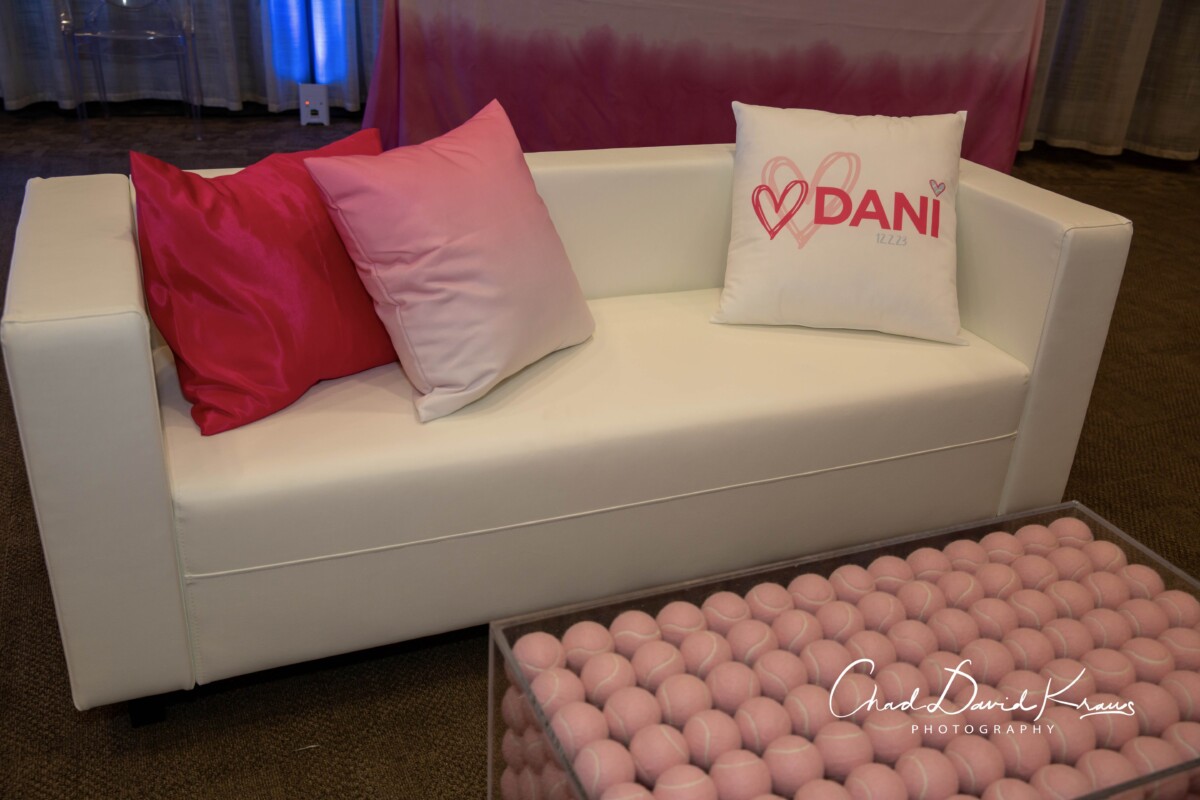
Photo: Chad Kraus Photography
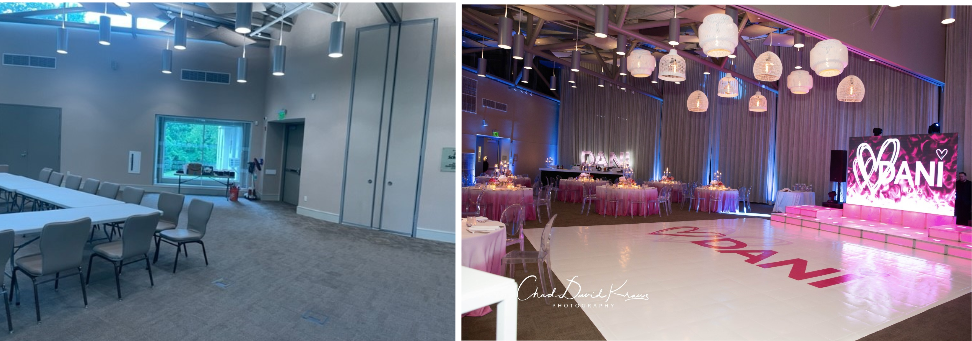
Photo: Chad Kraus Photography
A sea of pink ombre, white, and ice blue took over the social hall of their temple, Congregation Emanu-El, for an unforgettable take on tennis. A beautiful pink floral centerpiece complemented the pink ombre linens, pink heart-shaped table numbers, and white and pink ombre furniture.
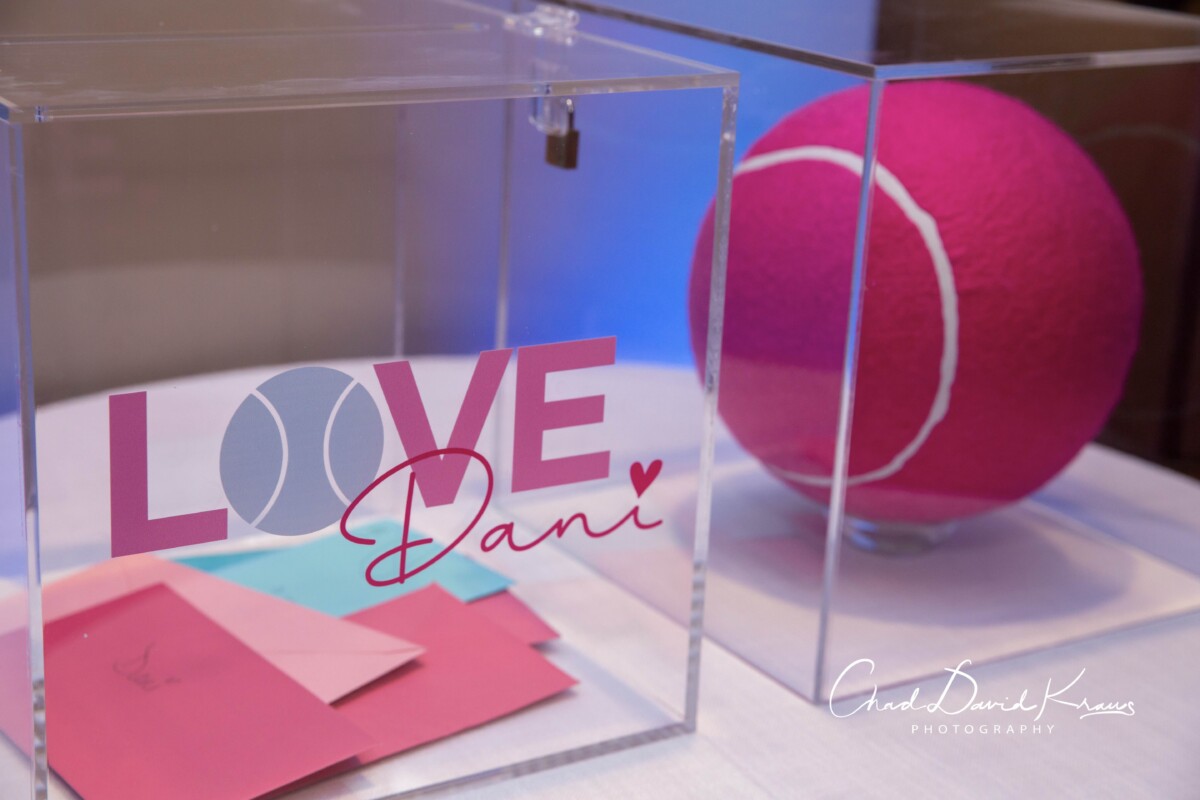
Photo: Chad Kraus Photography
When you walked in, there was a custom card box with a giant pink tennis ball for a creative sign-in moment. Kids and parents alike enjoyed the custom logo pillows on the lounge furniture and the coffee table filled with– yes, you guessed it, pink tennis balls.
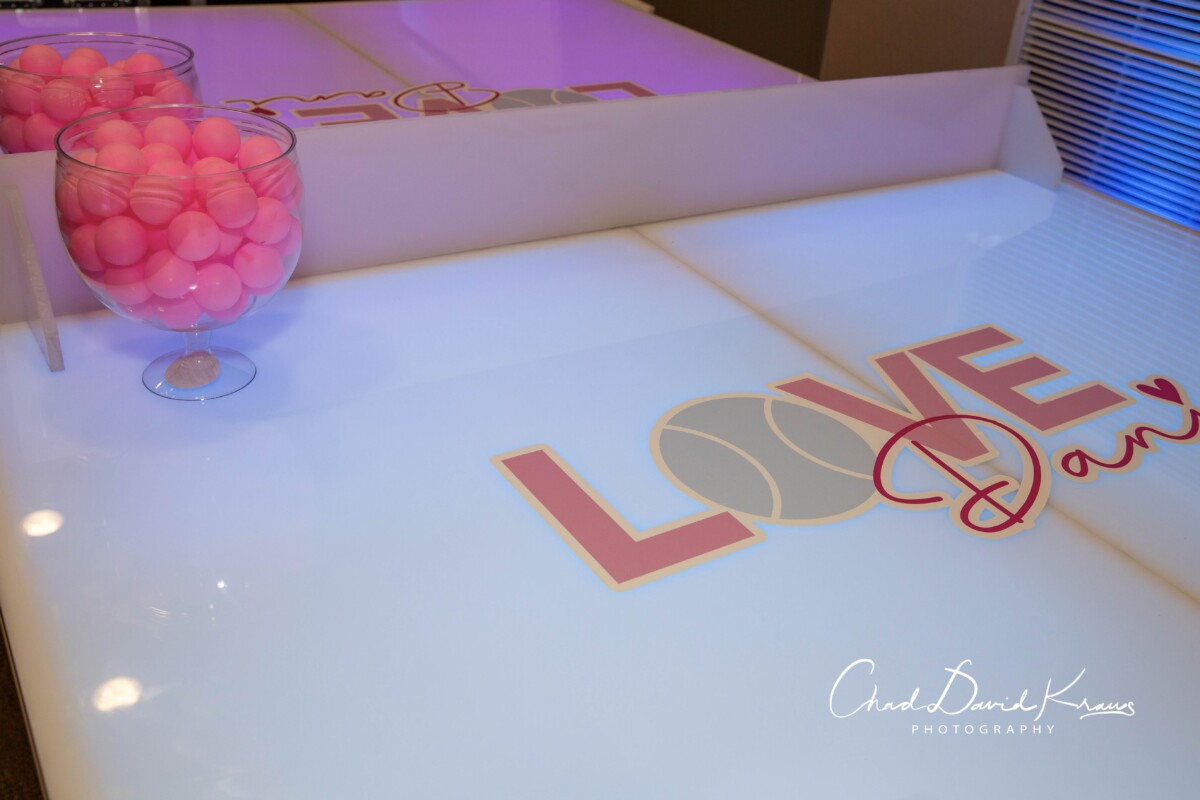
Photo: Chad Kraus Photography
Some families competed in ping pong on the pink LED tables that had glow-in-the-dark ping pong balls to go with them. Others gravitated towards the custom-branded Rollerball, an arcade game classic.

Photo: Chad Kraus Photography
The dance floor was upbeat, with great music and giveaways for logo-embroidered hats, printed sweatbands, and more. The front of Dani’s Bat Mitzvah sweatshirt had one of her heart logos in pink ombre rhinestones, and the back listed tennis tournaments around the world- a fun touch to an already fun theme.
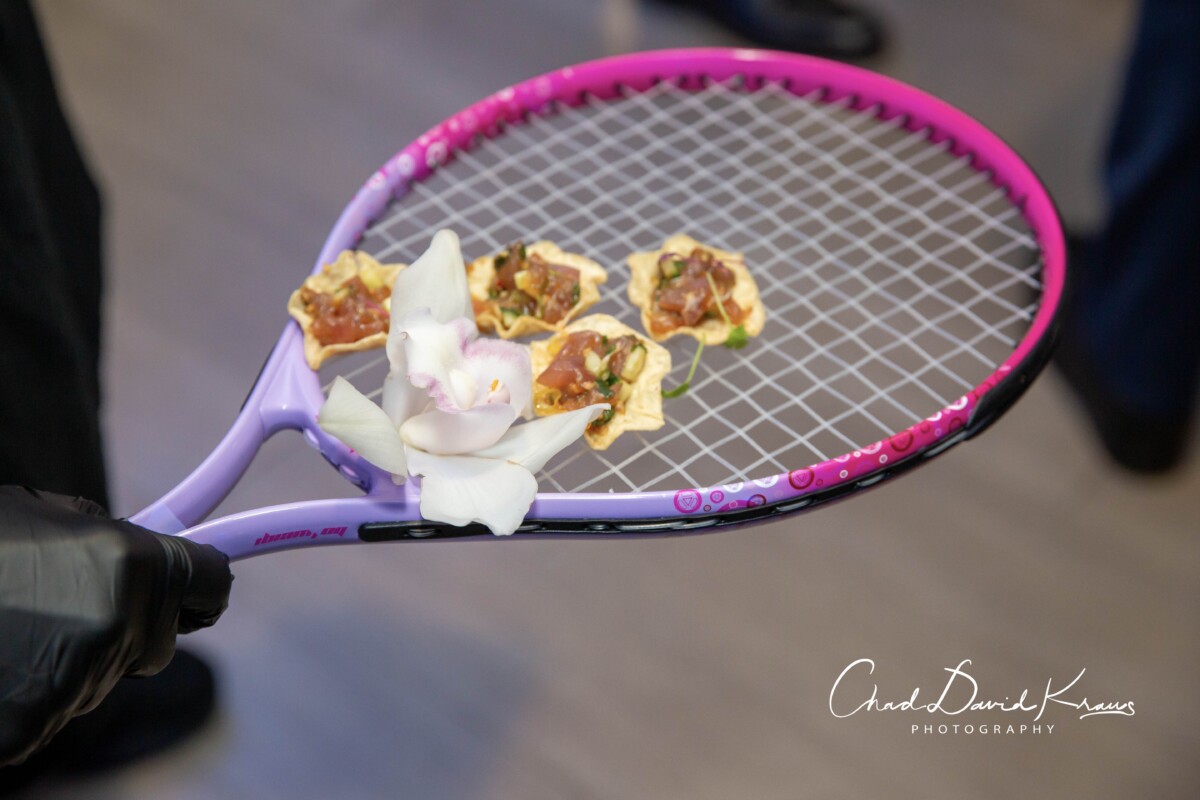
Photo: Chad Kraus Photography
While the kids held down the dance floor, parents enjoyed the hors d’ouvres served on Tennis racquets and the bar made of grass with Dani’s name spelled out in pink tennis balls. Everything was meticulously planned, even down to the signature drink: the Honey Duece from the US Open.
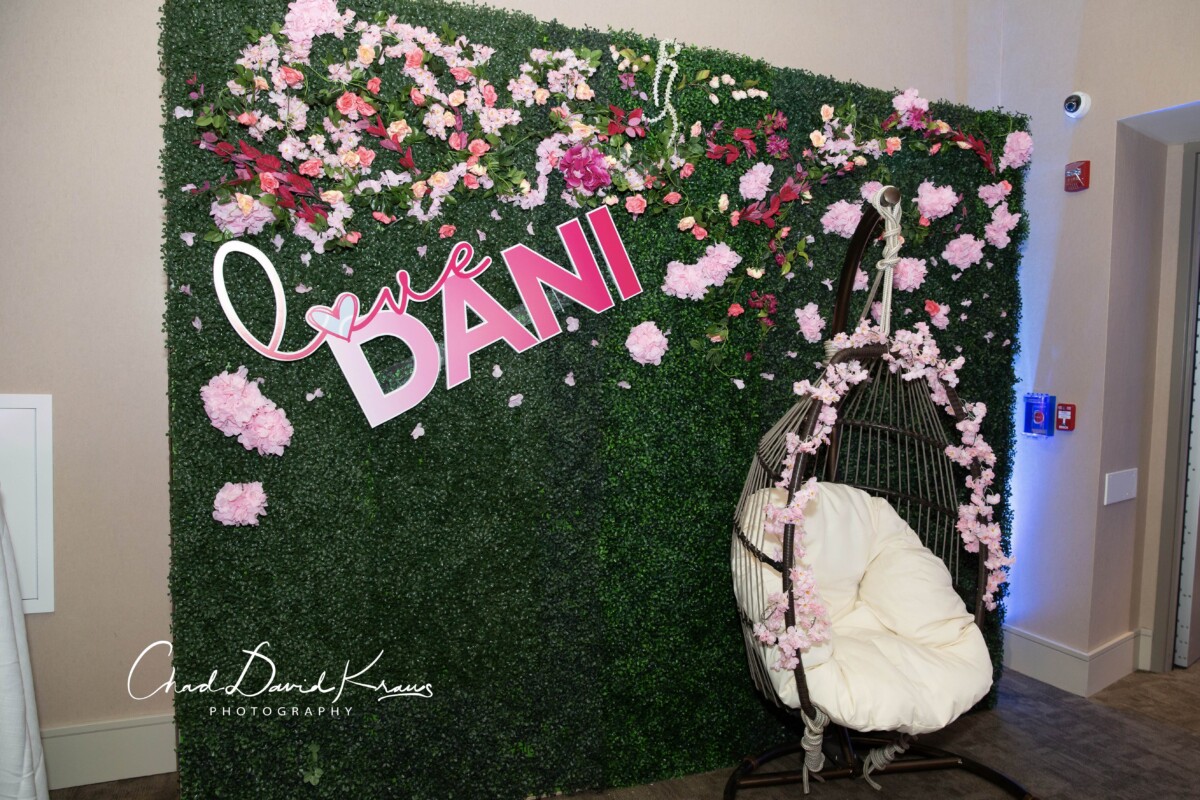
Photo: Chad Kraus Photography
All the amazing memories of Dani’s Bat Mitzvah were captured with a photo op, with groups of guests filtering in and out to take pictures in front of the grass wall and pink flowers.
At the end of the night, guests took home custom water bottles, coffee cups…and probably a pink tennis ball or two. Creative Bat Mitzvah themes are always the best, and Dani and family nailed this one with the iconic “Love” theme that all her guests loved! Melisa Imberman of The Event Of A Lifetime nailed this one!
March 20th, 2024
Photo by Andrea Piacquadio/Pexel Stock
By Drew Isserlis Kramer
Jewish people have a relationship with the b’nai mitzvah tradition. For some, the milestone comes with reverence, but for others a twinge of regret. Hopefully, the first experience of reading the Torah on the bema will launch a lifelong call to Judaism. However, for some Jewish adults, complicated feelings can linger. Perhaps the synagogue didn’t allow a woman to read from the Torah. Maybe the pressure of secular academics made religious study feel like a pain. Did parental pressure outweigh personal spiritual questioning? Did the moment pass without celebration, or did the glitz and glam of the party overshadow the true meaning now realized? Whether the memory of the b’nai mitzvah past prompts feelings of nostalgia or remorse, fear not. For many adults, there is an opportunity for a do-over.
Psst…A B’nai Mitzvah Throwback of Famous Celebs
A Talmeudic Tradition
While the “second b’nai mitzvah” might feel like a passing trend, it is actually a long-standing Jewish tradition. One can choose to chant the Torah to honor any number of b’nai mitzvah anniversaries, but the most common milestone is 70 years after reaching the age of 13. The reason many Jewish seniors chant their b’nai mitzvah parsha at age 83 is not arbitrary. To understand the custom, Jews look to the books. Psalm 90 of the Hebrew Bible laments the short 70 year span of human life, which passes quickly and often with struggle. From this passage, the number 70 takes on significance in Judaism. To celebrate the 70 year anniversary of one’s b’nai mitzvah is a blessing beyond expectation. Moreover, in some Jewish circles, to reach 83-years old can be considered reaching 13 in a second lifetime. As more people live longer, healthier lives, this ritual is becoming more common.
An Act of Free Will
Those fortunate enough to experience this honor of long life do so under vastly different terms than their first call to the Torah. Without the strong societal and parental pressures associated with the first go-round, this event is an act of free will. The motivation to have a second b’nai mitzvah comes from the individual’s desire to reaffirm religious affiliation. If the ceremony includes a d’var Torah (or speech), the event becomes all the more poignant as the b’nai mitzvah reflects on a lifetime grappling with spiritual and religious identity.
A Snapshot of the Jewish Experience
An 83-year-old in 2024 celebrated a b’nai mitzvah in 1954. Born in 1941, this group of octogenarians belongs to The Silent Generation, generally defined as people born from 1928 and 1945. Coming of age as Jews in postwar America, this group coped with the aftermath of the Holocaust, as well as the Jewish flight from intergenerational tenaments in cities to the sprawl of the suburbs.The b’nai mitzvah tradition became a central component of keeping Judaism alive in the wake of upheaval and change. The Silent Generation’s first b’nai mitzvah bears little resemblance to the pomp and circumstance of today’s celebrations. A second b’nai mitzvah can serve as an opportunity to reflect on the history of the tradition, the Jewish American story and the importance of keeping the covenant alive for generations to come.
A Celebration of Life
Whether it is the first or second time around, the b’nai mitzvah is a celebration of life and the passage of time. In the first b’nai mitzvah, family and friends gather to mark the end of one chapter – the passage of childhood into adulthood. The child’s community comes together with awe, marveling at the miracle of growth and anticipating the joy of graduation, marriage and birth to come. By rooting life milestones in Jewish tradition, the family hopes to assign deeper meaning to the highs and lows of life. However, what the b’nai mitzvah child does with that hope is still unrealized. A second b’nai mitzvah comes with hindsight. While one’s relationship to religion can ebb and flow, at the sunset of life, this individual chose to celebrate a lifetime lived Jewishly. The occasion gives the individual an opportunity to reflect on his or her life experience and the importance of Judaism in that journey. It is also a rare moment to assemble and honor the family and friends that came along for the ride. Surrounded by the warmth of cherished community, the second b’nai mitzvah celebrates wisdom, enduring faith and a profound sense of gratitude for the blessings of yesterday, the joys of today, and the promise of tomorrow.
February 20th, 2024
When the B’nai Mitzvah Student Doesn’t Speak Hebrew
By Drew Isserlis Kramer
In some families, children are exposed to Hebrew from birth. For children of those communities, speaking and reading the ancient language of Judaism begins early and often, making preparation for B’nai mitzvah much ado about nothing when approaching age 13. In more secular circles, the first exposure to the ancient language of Judaism might come in middle childhood when enrolled in a formal Hebrew school program. While Synagogue Hebrew schools have a tried and true system for Hebrew language instruction, each year, there are always a few children that make it to b’nai mitzvah season without the skills necessary to read the Torah. If your child is struggling to learn Hebrew, fear not. Below is a guide to getting your child in gear with whatever time you have left before the big day.
Trust the Hebrew School System
While some kids might be behind due to temple mischief and too many other commitments, most kids after several years of regular instruction will learn the letters and how they form words. At Westchester Reform Temple, the youngest Hebrew School students begin to learn letters and words through movement. Through playful word exercises, Kindergarten through second grade students begin to understand letters and sounds, like getting up and down (לקום – לשבת – לקום). In middle childhood, 3rd, 4th and 5th graders will begin to study prayers, which helps them to understand common melodies and phrases. When the child reaches 6th grade and begins to really focus on b’nai mitzvah preparation, the clergy will have had many years to assess and understand your child’s capabilities and unique learning style. Even if the clergy doesn’t expressly ask you to share your child’s learning style, be up front with any known learning issues that might create challenges for b’nai mitzvah preparation. The clergy understands how to reach students across a broad spectrum of capability.
Psst…Top 10 B’nai Mitzvah Gifts that Also Support Israel
Find A Chavruta
A chavruta is a partner. In traditional Talmudic study, scholars will pair off with a rabbi or form a small group to interpret and debate Torah portions. Many synagogues provide 1:1 tutoring with clergy in their b’nai mitzvah preparation plan. However, some students might require additional help to prepare for the main event. Some families seek private tutors outside of their synagogue’s Hebrew School program to ensure the b’nai mitzvah student’s success on the bema, or pulpit. For students that have unique learning styles, it can be helpful to have private 1:1 instruction that is tailored to those needs. It also ensures that students carve out time in their busy week to devote to practice.
Check Your Expectations
A child reaches b’nai mitzvah just by reaching the age of thirteen. The tradition of reading from the Torah or Haftorah is not necessary to honor the occasion. In Reform temples, there is often openness to read transliteration or abbreviated materials. Even in a more traditional setting, temples will adapt the b’nai mitzvah’s participation in the ceremony to suit the needs of the child. In more observant communities, clergy will adapt the child’s participation in the ceremony to suit the needs of the child and the observance of the congregation. Not every child can lead a service, but perhaps the child can do the blessing before and after the torah is read. Many families choose to meet their child where they are, finding other ways to honor their children’s transition to adulthood in synagogue. Not every child can lead a Saturday morning service. Rather than a torah portion, some children opt to do the blessing before and after the torah is read. If your child is truly struggling to prepare for the big day, give all of yourselves a break and figure out what is reasonable for your child to feel included in the ritual of the ceremony. If you are open to reframing your child’s participation on the bema, the experience could become less stressful and more meaningful.
Remember the Purpose
Even if the ceremony looks different than you imagined, remember the purpose of the b’nai mitzvah is not a perfect prayer. However you choose to ceremonially mark the transition from childhood to adulthood, the most important piece is to inspire a positive Jewish identity and to foster a sense of belonging. Whether or not the child demonstrates fluency in Hebrew at b’nai mitzvah is not the goal, but rather a commitment to community and a lifelong expression of Judaism.
February 13th, 2024
When the B’nai MItzvah Questions God
By Drew Isserlis Kramer
Is he an old bearded man in the sky? Or is she an all-powerful arbiter of good or bad, life or death? Is it a life force within all of us, an energy connecting us to the birds, the trees, the afterlife and our iPhones? As I say to my five-year-old when he asks tough questions about God, in life, there are many mysteries without definite answers. I tell him God is a loaded subject. Not everyone chooses to believe. And not everyone’s belief in God looks the same. At the heart of Judaism is a commitment to worship a single God. Humans fought and died for differences in that spiritual interpretation for thousands of years. To many modern-day people, the bloodshed over this unseen metaphysical power is enough to abandon God entirely. As a result, belief in God across all organized religions is on the decline, particularly among young people.
Still, according to a 2020 Pew research study, half of American Jews who were raised Jewish or had at least one Jewish parent say they had a bar or bat mitzvah. The devotion to the coming-of-age tradition, which asks for acceptance of God’s covenant, continues. In spite of that family commitment, some young b’nai mitzvah scholars struggle with their responsibility to study when their belief in God waivers or is non-existent. If you are a parent devoted to the b’nai mitzvah tradition but your child is questioning, I invite you to create debate.
Psst… Top 10 B’nai Mitzvah Gifts that Also Support Israel
“Tell me about the God you don’t believe in,” responds Senior Cantor Amanda Kleinman of Westchester Reform Temple in Scarsdale, New York. In her twenty years of cantorial work, Cantor Kleinman counseled many pre-teens struggling with their reason for being in a b’nai mitzvah program. When I asked how to approach such a student, Kleinman suggests you learn how the child defines God. Some children do not relate to the concept of an all-powerful Oz, lording over humanity. For children who have experiences of loss, they grapple with how God could exist when good people get sick and accidents happen. We live in a complicated world. It is hard to reconcile pain and suffering with the presence of an entity that can change all of that, but doesn’t.
In his book Bad Things Happen to Good People, famed author and Rabbi Harold Kushner wrote, “I believe in God. But I do not believe the same things about Him that I did years ago, when I was growing up or when I was a theological student. I recognize His limitations.” Kushner goes on to explain his choice to look at God as limited by the laws of nature and human free will. He stopped holding God responsible for illnesses, accidents, and natural disasters, because for him, he “gained little and lost so much” when he blamed God for those things.” In Judaism, there are 100 different names for God. God is so many things. Sharing other conceptions of God can help the child to see outside of the King of the Universe narrative and explore other interpretations that may open the child’s mind.
Or not.
For children that choose to continue questioning, God is always there. At different phases of life, one might feel differently on the topic. It is OK to feel doubt about things we cannot sense with anything, but our intuition. However, there are more reasons to maintain tradition beyond spiritual order. To be Jewish is an identity that goes beyond divine belief. Judaism is an Ethno-religion, a classification for people who share a common ancestral heritage and religious affiliation. As Jewish people, we are linked to a rich culture and historical experience, which, as our story of persecution reminds us, cannot be taken off by renouncing theological beliefs. Speak with your child about your favorite parts of being Jewish. Summer camp, bagels and lox, finding the afikomen, being lifted on a chair during the horah–like a b’nai mitzvah, being Jewish is joyful. A child who wrestles with God might love noodle kugel. Explore your family’s traditions in the context of your ancestral history. Share that Bubbie’s cholent recipe came off the boat with her from Russia to Ellis Island. Connect your love of tradition with your gratitude for the people that gave you the freedom to live Jewishly–and those still fighting for it today.
Whether or not the child believes in God, the b’nai mitzvah is a celebration of Jewishness. It is a statement of commitment to the future of this tiny group of people with a unique legacy and spiritual life. While your thirteen-year-old might not see it today, Jewish identity ebbs and flows. Judaism is always there to help explain the many magical mysteries of life and offer meaning and purpose when it gets hard. If b’nai mitzvah occurs during one of your child’s seasons of doubt, keep demonstrating its joy and light, and say, “Because I said so!”
January 15th, 2024
What’s in a Hebrew Name? A B’nai Mitzvah Call to Action
By Drew Isserlis Kramer
In a Kindergarten school yard, my son heard a rumor that he is not really Jewish if he does not have a Hebrew name. Shocked, he returned home demanding to know his own religious moniker. With shame, his father and I admitted that he didn’t have one–yet. Typically, a Jewish boy receives his Hebrew name at his bris, the ritual circumcision occurring eight days after birth. A Jewish girl receives hers at a baby naming ceremony during her first year of life. Since our boys were circumcised by doctors in the hospital, we never got around to the business of naming. Now, with a fire lit by peer pressure, we sought guidance from our home synagogue. Do we just pick one? Raised without much religion, I didn’t have a naming ceremony or a b’nai mitzvah to inspire selection. Finding faith later in life, I still feel like a bit of an outsider at Jewish life events that reference a Hebrew name. At my wedding, I felt a touch of embarrassment when I signed my ketubah (the Jewish marriage contract) with my English name. At b’nai mitzvahs, I feel a twinge of envy when I hear a child called to the Torah by an alias ringing with culture and family history. If your child is gearing up for a b’nai mitzvah without a Hebrew name, read on to understand the significance of the naming tradition and how to select one before the big day.
Connecting Generations of Family Long After the B’nai Mitzvah
An Ancient Tradition
In Judaism, names are more than a way to distinguish one person from another. The Torah and its interpretations teach us that the name is key to the soul. Names tell a story–our story. As Jews, our story begins with a sense of separateness and belonging. A Hebrew name unites us with our people and our history, but also reflects a distance from the mainstream society that surrounds us. As a result, the Jewish practice of double naming, selecting one from the Jewish tradition and one from the surrounding non-Jewish culture, has ancient origins. First evidence of the practice came from the region that is present day Israel. During the time of the Second Temple (140 BCE to 37 BCE), when Greeks ruled the region, Jews of the day put their Hebrew name first and a Greek name second. As control of the region changed from dynasty to dynasty, and Jews fled to other territories, the double naming practice continued, while naming conventions shifted.
Today, Jews typically select a Hebrew name that honors a deceased relative. The child will take the whole Hebrew name or the parents will select a new one with a similar sound. In some cases, the parents will also choose a secular name that uses the same letter or sound as the person honored. For example, my son’s name Harrison is after his grandparents, Herbert and Helen. His Hebrew name Haim, meaning life, reflects his passion and energy, but also roots him in his family history.
A Ritual Purpose
Hebrew names serve a particular purpose in Jewish prayers and ritual. Whenever Jews are called to read from the Torah, they are identified by their Hebrew name and that of their father (and occasionally mother). Using the the word “ben” or “bat,” meaning “son of” or “daughter of,” Jews link the Hebrew name of the individuals that brought them into Jewish life. For example, my son Harrison will be called Haim ben Osher, his father’s Hebrew name. The reference to family lineage creates a link on a chain to ancient times. In daily prayers, and during Jewish life cycle moments, this intergenerational Hebrew name plays a part. From bris or baby naming to b’nai mitzvah to a wedding Ketubah to prayer for recovery from illness to marking a grave to honoring the anniversary of the deceased, the Hebrew name calls these souls from our lips to God’s ears.
A Name for Interfaith Families
Naming becomes complicated when one parent is not Jewish or the family and/or child converted. Traditional circles would not use the name of a non-Jewish parent in a Hebrew name. Rather, they would select biblical names for themselves and their parents. For example, the child might be Ruth bat Avraham v’Sarah because Ruth is the daughter of Sarah and Abraham in the Bible. This is not to exclude or insult the child’s biological parents, but to connect her to Jewish history. That said, in some Reform congregations, the synagogue will honor a non-Jewish parent’s name in the naming structure.
A Name Fit for a Teen
When naming a baby, only the parents have a say. For a rising teenager, there is another extremely vocal cook in the kitchen. Include your tween in the selection process. Are there relatives your child wishes to honor? Are there biblical characters with stories that resonate? Talk about the sentiments that went into choosing the English name, and whether those same qualities are important or observed in the child today. Work with your clergy and temple personnel to select a name with meaning. Once chosen, honor the decision with a blessing at a Friday night or Saturday morning service. This is also an occasion to mark with celebration.
If your family neglected to select a Hebrew name, remember that it is never too late. Once the b’nai mitzvah milestone passes, the name is a gift that continues to give. In Judaism, reciting the name created from the combination of sacred Hebrew letters is a spiritual call. In my Jewish journey, I’ve come to learn that a Hebrew name is a conduit of connection to a higher power. As I created meaningful names for my children, I took the opportunity to select one of my very own. Today I am Tzpora, Hebrew for bird and the free-spirited, fearless mother of Moses’ two sons. Her story connects with my spirit animal and links me to the long and fascinating history of the Jewish people. If you have the unique opportunity to pick a Hebrew name for a child entering adulthood, give the gift of a title rooted in family history and a prophecy for the future. A name is a story–-a call to arms.
December 14th, 2023
When the B’nai Mitzvah Theme is Family Feud
By Drew Kramer
Psst…Check out A Culture of Study: The Jewish Value of Education Prepares for B’nai Mitzvah
Don’t let the Instagram photos fool you. No matter how happy a b’nai mitzvah appeared on the Internet, all family gatherings provoke a wee bit of drama. Family is complicated. It would be lovely to imagine a world where feuds fizzle in the context of shared family simcha, or joy.
However, in reality, family events like a b’nai mitzvah can become a forum for old fights to flair. When a child reaches b’nai mitzvah, it comes in the context of the family’s story–and all families have their warts. Whether your child’s milestone comes in the wake of a divorce or a fight over granddaddy’s fortune, the event can become loaded by the coming together of people for whom the fine line between love and hate skews hostile. For the teenager facing the stress of public speaking in a foreign tongue, the added anxiety of a public airing of grievances among strained relations can become too much to bear. If you are feeling anticipatory anxiety about a family fight at your child’s b’nai mitzvah, begin with a deep breath and take steps to prepare yourself and your child for the emotional weight of the day.
No matter the magnitude of the past slights, center all family members around the shared support and love for the child. If possible to address the sources of tension directly without igniting warfare, remind the most contentious players that love and light is the theme of this event. After gently setting settable expectations, set yourself up for success. Create seating arrangements that allow for space between difficult people. If giving one relative the honor of giving a blessing will create animosity with another, spare yourself the headache and invite all or none to publicy wish the child well.
If there are friends or family members who are notoriously toxic and unable to control their behaviors, consider keeping your guest list small. While grudge holding is not a behavior anyone wishes to hand down, save reconciliation for another time and place. It is OK to keep the room filled with only the people that lift you up. In the event that a challenging individual cannot be omitted from the celebration, grit your teeth in a smile and do whatever it takes to keep the energy warm and inclusive. Just because negative people are in the room, doesn’t mean that their energy has power. Good vibes begin with the hosts. Set aside your own differences for the day and pretend like nothing happened. Greet the whole room with open arms. You can do it.
While I hope this would be enough to create a drama-free family event, one has to prepare oneself for the event of a dramatic scene. “It’s natural for emotions to be heightened during the special day, especially if it doesn’t look like how you once expected it to,” acknowledges Lauren Tetenbaum, a Westchester-based mental health therapist who provides cognitive behavioral therapy and coaching to women. She adds, “If emotions run high, try to regulate your stress through mindfulness exercises, including deep breathing.” If your buttons are pushed, do not give in to the urge to react. Walk away. Shift your attention to your child and the pleasure of celebration. As Tetenbaum encourages, “focus on celebrating with the friends and family who bring you joy.”
The big day will come and it will go. It will never be perfect in its execution. The food might be cold. Your aunt will snub your husband’s cousin. Someone will fall on the dance floor. In the aftermath of this long anticipated event, the lows will hopefully fade into funny anecdotes that made the day more memorable. Only the highs are preserved in photographs. What your child will remember is the love of family and friends coming together in the unified celebration of this coming of age event in Jewish life. At this nexus of childhood and adulthood, let the b’nai mitzvah celebration be a model for forgiveness and empathy–even if just for one night.
December 12th, 2023
The Anxiety and the Ecstacy of Becoming a B’Nai Mitzvah
By Drew Isserlis Kramer
Psst…check out Connecting Generations of Family Long After the B’nai Mitzvah
Anxiety is part of the Jewish experience. As if intergenerational trauma from centuries of antisemitism wasn’t enough, children approaching adolescence must grapple with the anticipation of the public spectacle of becoming a B’nai Mitzvah. While the coming of age ceremony is an important right of passage in Judaism, for many young people, the pressure of chanting Hebrew in public and sitting at the center of a large, elaborate party is enough to call for smelling salts. As a shy, but intellectually curious child, I enjoyed the history lessons of my first year Hebrew School.
However, the stress of performing at a Bat Mitzvah service and celebration prompted my decision to quit at the tender age of nine years old. While some children are born with the confidence of a Hollywood leading lady, most rising teenagers suffer from the same angst and awkwardness that stunted my Jewish learning. If you sense your child’s dread for the milestone that means so much to you and your family, fear not. With the right coping strategies, your child can rise to the challenge.
Anxiety is Normal
According to child and adolescent therapist Julie Schnur, an LMSW based in Westchester, “when preparing for b’nai mitzvah, it is important to remember that feeling anxious is totally normal!” While it may seem like other children feel excited to select party dresses and the latest Air Jordans, Schnur reminds that “most kids feel nervous about leading a service.” She urges parents to “normalize that being in front of lots of people and speaking and singing in Hebrew can feel scary.” Resist the temptation to dismiss anxiety. Rather than push it away with assurances that all will be fun and fine, Schnur advises parents to “allow the child to feel nervous” on the path to accepting that fear.
Being Empathic
Family members can show empathy and model resilience by “sharing their own stories of how they felt at their own b’nai mitzvah.” Doing so will create connection by “relating to their fears and making them feel less alone.” Sharing one’s own vulnerability “keeps lines of communication open” and builds trust, which is particularly important as this age group struggles to assert independence and separateness. By sharing the details of the parents’ own experience, “children see that these are feelings that are OK to feel and safe to express.”
While it may feel better to avoid excessive discussion of the triggering event, it is important to set the child’s expectations and include them in the planning of the details of the day. Schnur suggests working with the child and clergy to “create a day that best fits the comfort level and personality of the child.” While this might not reflect the vision for the rest of the family, it is important to create a program that prioritizes the child’s comfort and sets them up for success. Even in more traditional temple environments, clergy are often very willing to design a service that suits the child’s unique needs. The goal is to create a positive experience that welcomes the child to Jewish adulthood with warmth and love.
Strategies for Anxiety
While it is important to meet children where they are, there will still be anxiety as the big day approaches. Accepting that anxiety comes with developing coping strategies that will make the child feel prepared to meet the challenge. Schnur recommends “breathing exercises, visualizations, and (quiet) fidget toys that can be used on the day of to manage the anxiety in the moment”. Armed with these strategies, “the child can feel like they have a toolbox to utilize to navigate stress in the moment.” Additionally, Schnur recommends carving out time in the days and weeks leading up to the event to relax and shift focus. Journal writing or physical activity can be extremely useful in reducing anticipatory anxiety and controlling negative thoughts.
Importance of Mindfulness
The ability to control one’s anxiety through mindfulness and acceptance of what we cannot control is a lesson that will serve all individuals well throughout adulthood. While the b’nai mitzvah milestone challenges children to study and overcome the stress of the day, it is a right of passage that teaches resilience. In everyone’s life struggle and anxiety will come. Through that struggle comes strength. That in and of itself is the most important lesson of all.
A lot of Pediatric dentists like to promote sedation for fillings.
December 12th, 2023
A Culture of Study: The Jewish Value of Education Prepares for B’nai Mitzvah
By Drew Isserlis Kramer
Psst..check out Going to a B’nei Mitzvah: A Guide for the Non-Jewish Guest
Judaism is a religion of study. At the center of Jewish study is the Torah. The Torah is the name given to the first five books of the Hebrew Bible. Directly translated to English, Torah means “to teach.” The Torah’s stories of creation, the covenant and the struggle to keep it guide the reader to live with meaning and purpose. For thousands of years and to this day, its teachings help people manage through times of triumph and tragedy, as well as navigate the regular challenges of everyday life. In doing so, Jewish people gain a framework for living that creates ritual and regularity in a world of chaos. In addition, it cultivates a devotion to education and thoughtful debate that promotes a culture rich with intellectual curiosity.
Within the Torah, the Mitzvah of Chinuch, or the duty to educate the next generation, begins before B’nai Mitzvah. The term chinuch, or “training,” is used because it is learning that comes before reaching Jewish adulthood. Without assigning adult responsibility to children, chinuch is an “inauguration” or an initiation to Jewish customs, values and faith. Early exposure to Judaism through school and family life gives children an association between the warmth of tradition and community that will foster enthusiasm and intellectual interest into adulthood. The intention is that the pride and connection to Judaism will establish a commitment to study as they approach preparation for the b’nai mitzvah–the ceremonial transition from childhood to adulthood at the age of 12 or 13.
Preparation for a b’nai mitzvah requires dedication. Learning Hebrew and memorizing and interpreting a Torah portion requires real work. Students often struggle with reading Hebrew and understanding ancient texts, especially with a loaded academic and extracurricular life outside of religious school. The b’nai mitzvah becomes an effort of both time and substance. If your child is grappling with the academic pressure of an approaching B’nai Mitzvah, several Jewish traditions can help to inspire achievement.
Understand the System
To support your children in their preparation, it is essential to understand the scale of the task at hand. When a B’nai Mitzvah reads from the Torah, the undertaking is not just to read the ancient Hebrew characters, but to chant the words in the melodies of the religion’s oral tradition. Students of Torah must learn the words and the melodies like singers learn sheet music. Like in music, Torah comes with a notation system that indicates the “flavor of the reading,” or trope. Trope, also known as Hebrew cantillation, dots, dashes, jagged zigzags above and below the words are the punctuation symbols our ancestors used to conduct their ancient songs.
To complicate matters further for the young Torah student, the punctuation symbols are not written in the Torah scroll text itself. Students must memorize the melodies, using a complex system of symbols and colors. While many b’nai mitzvah candidates begin to understand this system early in childhood, for more novice Torah students, this is an immense task.
Personalize Learning
According to Rabbi Sasha Baken at Westchester Reform Temple in Scarsdale, New York, preparation for b’nai mitzvah is not a one stop shop. When preparing a child for b’nai mitzvah, Baken emphasizes that “each student is different. What works for one child may not work for another.” As a result, every cantor or rabbi must cater to the unique needs of every student. Even without a documented learning difference, families of b’nai mitzvah students should connect with clergy to discuss the child’s learning style, preparing a more visual or oral approach, depending on preferences. Many cantors will record the torah portion so that students who prefer to learn by ear can better connect sound to symbols and words. Depending on the requirements of the congregation, some synagogues will allow students to read from the portion from a copy with the trope symbols, or even phonetically written words. Speak with your child’s academic school teachers to better understand what works for that student in the classroom.
Seek a Havruta: Learn in Pairs
Jews rarely study alone. Traditionally, Talmudic study is a social and even communal activity. At many synagogues, cantors and rabbis will tutor students on their Torah portion, holding weekly face-to-face sessions to map trope onto the hebrew letters and chant together. These regular meetings with clergy will give the child the necessary 1:1 attention, educating the student about the system and meaning for the portion.
Tutoring sessions with clergy are essential, but not the only practice required to succeed on the bimah. Encourage your child to seek a “havruta” or a partner in Jewish learning. When paired with a peer, the pair can help each other dissect their Torah portions, learning its meaning and applying it to their own lives. Judaism values lively discussion and debate, making the material come to life through opinion and opposition. While weekly tutor sessions with clergy is important, the student might feel embarrassed to question or give a full opinion to someone with more experience and age. The additional support of a peer offers the freedom to make mistakes and question, which could create confidence and more thoughtful interactions with teachers later.
For parents, Rabbi Baken encourages them to “study the Torah portion with their children, if they’re interested.” If parents cannot read hebrew, “support kids with writing the speech, helping to interpret the lessons of the portion and draw similarities to modern teenage life.”
The Sum of Study
While preparing for a b’nai mitzvah can feel like an intimidating commitment, recall that students are studying well before 13. Chanting the four questions and Hanukkah prayers, young children begin to learn trope. From family services to Hebrew school, they string letters into words, growing to decipher blessings and prayers. A childhood connection to Judaism gives Jewish youth the skills and commitment to learning, as well as an appreciation for the beautiful oral tradition handed down to the Jewish people for centuries. In the Mitzvah of Chinuch, children learn the nuts and bolts of a lyrical language that they will use to announce their call to adulthood, but also their commitment to Judaism and ensuring the future of this tradition.





























